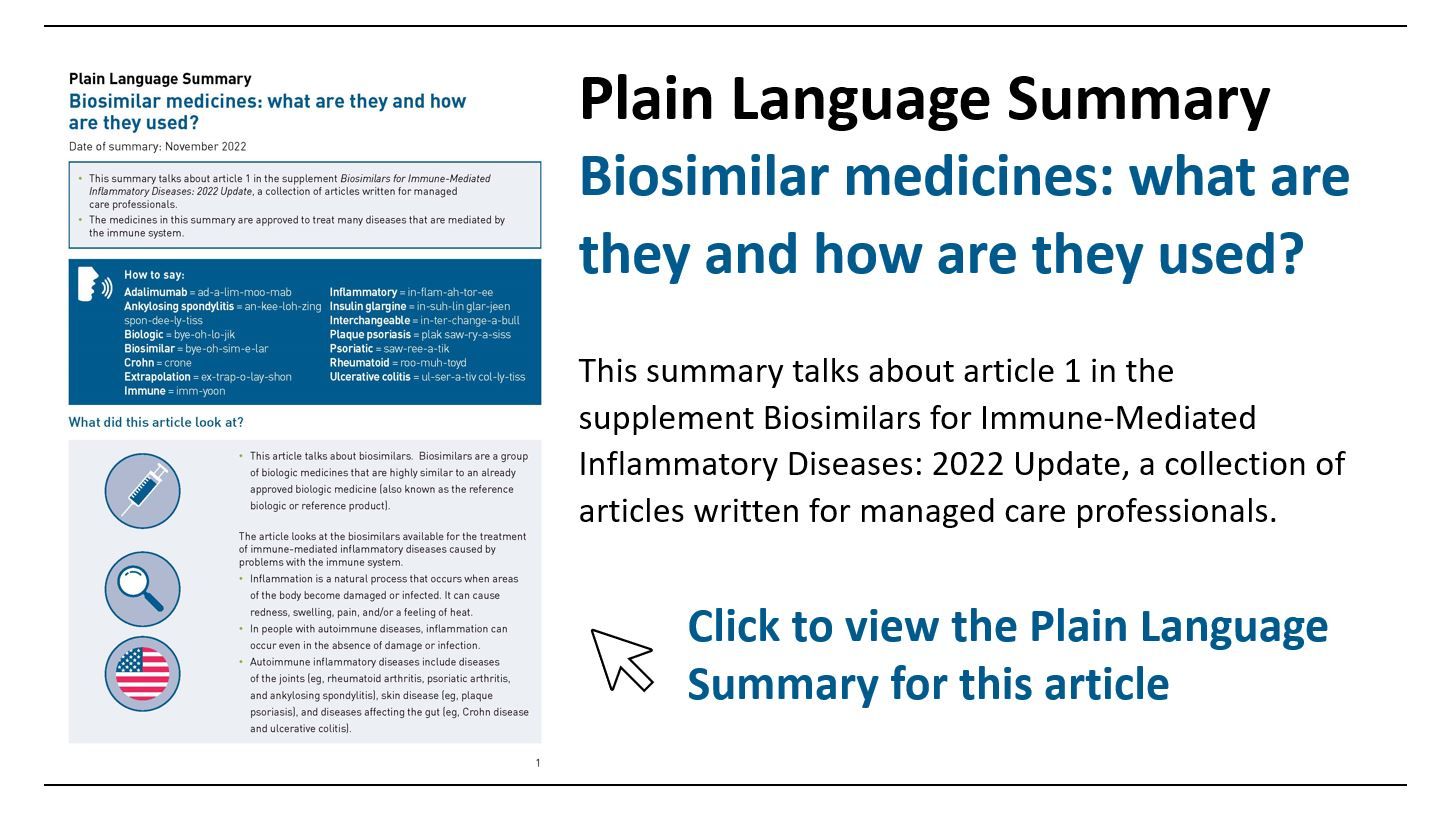- Center on Health Equity & Access
- Clinical
- Health Care Cost
- Health Care Delivery
- Insurance
- Policy
- Technology
- Value-Based Care
Overview of Biosimilars for Immune-Mediated Inflammatory Diseases: Summary of Current Evidence
ABSTRACT
Biosimilars offer the potential to deliver substantial cost savings in biologic therapy and to contribute to increased patient access to biologic treatments, both of which are particularly relevant for immune-mediated inflammatory diseases, given the number of patients affected by and receiving treatment for these conditions. For the United States to benefit from bringing biosimilar pipeline products to the market, legal and price-related barriers to competition must be addressed. In addition, education of prescribers, patients, payers, and providers is essential to increase uptake as biosimilars reach the market. This article discusses biosimilars currently available for the treatment of immune-mediated inflammatory diseases in the United States, reviews the main concepts related to regulatory approval of biosimilars by the FDA, and considers potential barriers to the uptake of biosimilars.
Am J Manag Care. 2022;28(suppl 12):S217-S226. https://doi.org/10.37765/ajmc.2022.89296
For author information and disclosures, see end of text.
Introduction
Biosimilars are here to stay, and they are being used across multiple diseases and therapeutic areas. To maximize their benefits, there must be a greater understanding of resistance to their use and development of strategies to overcome barriers and increase uptake among prescribers and patients alike. Here, we discuss biosimilar products available for the treatment of immune-mediated inflammatory diseases (such as rheumatoid arthritis [RA], plaque psoriasis [PsO], psoriatic arthritis [PsA], Crohn disease [CD], ulcerative colitis [UC], and ankylosing spondylitis [AS]) and review potential barriers to their uptake in the United States.
Biosimilars are biologic products that are equivalent or highly similar (in safety, purity, and potency) to an existing originator or reference biologic (called the reference product) approved by the FDA and with no clinically meaningful differences to the reference product (see Figure 1).1-4 Biosimilars approved by the FDA for use in the treatment of immune-mediated inflammatory diseases are presented in Figure 2 and include reference products for tumor necrosis factor-alpha (TNF-α) blockers (infliximab, etanercept, adalimumab) and rituximab.5-8 Briefly, infliximab (Remicade; Janssen Biotech) is indicated in the United States for the treatment of RA, CD (adult and pediatric), UC (adult and pediatric), AS, PsA, and PsO. Three FDA-approved biosimilars referencing infliximab (Remicade) have been marketed: Inflectra (infliximab-dyyb; Pfizer), Renflexis (infliximab-abda; Organon), and Avsola (infliximab-axxq; Amgen). A fourth biosimilar, Ixifi (infliximab-qbtx; Pfizer), will not be launched in the United States.5 Etanercept (Enbrel; Amgen) is indicated in the United States for RA, polyarticular juvenile idiopathic arthritis (JIA), PsA, AS, and PsO. Two FDA-approved etanercept (Enbrel) biosimilars—Erelzi (etanercept-szzs; Sandoz) and Eticovo (etanercept-ykro; Samsung Bioepis)—are subject to ongoing litigation and have not been launched.5-9
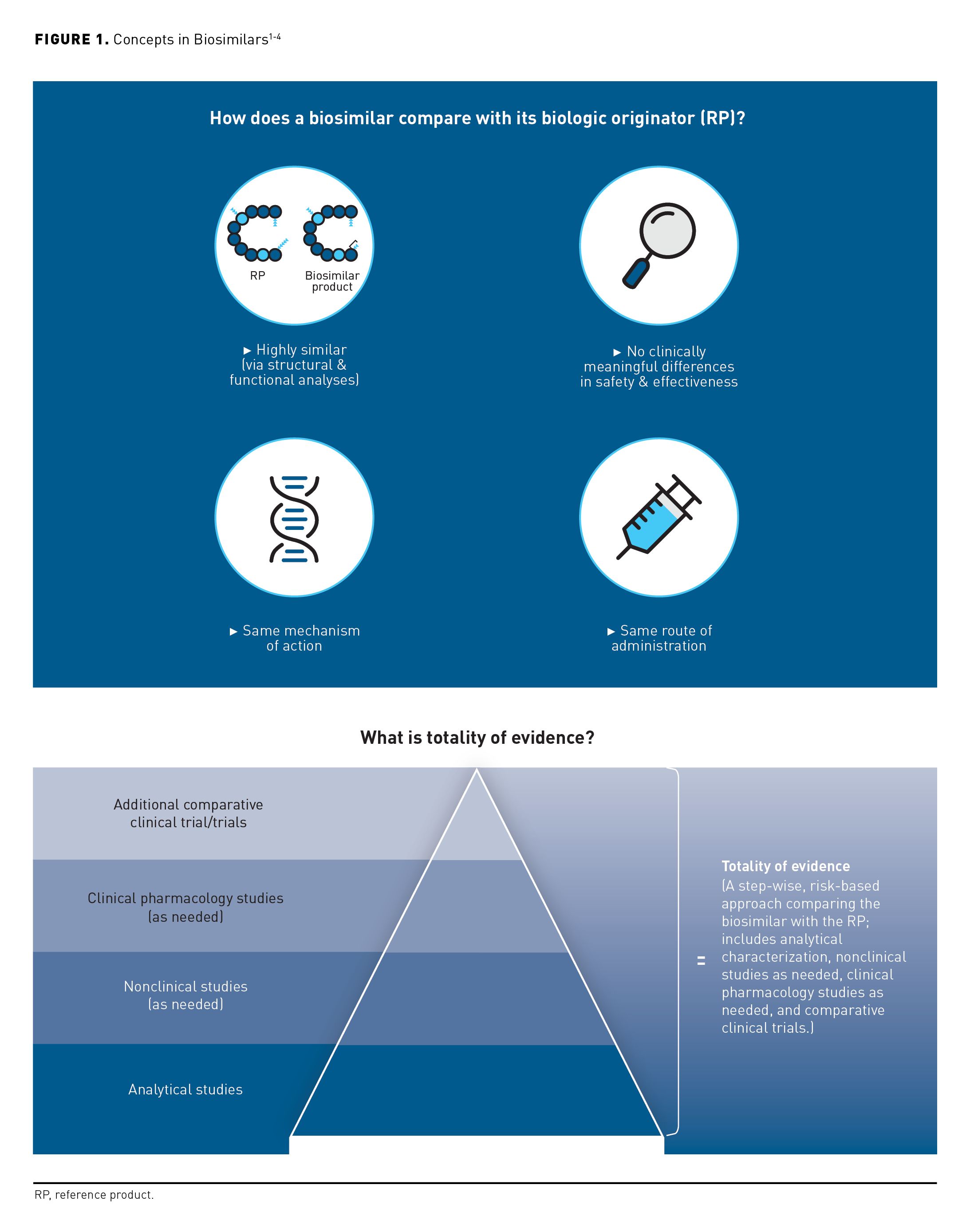
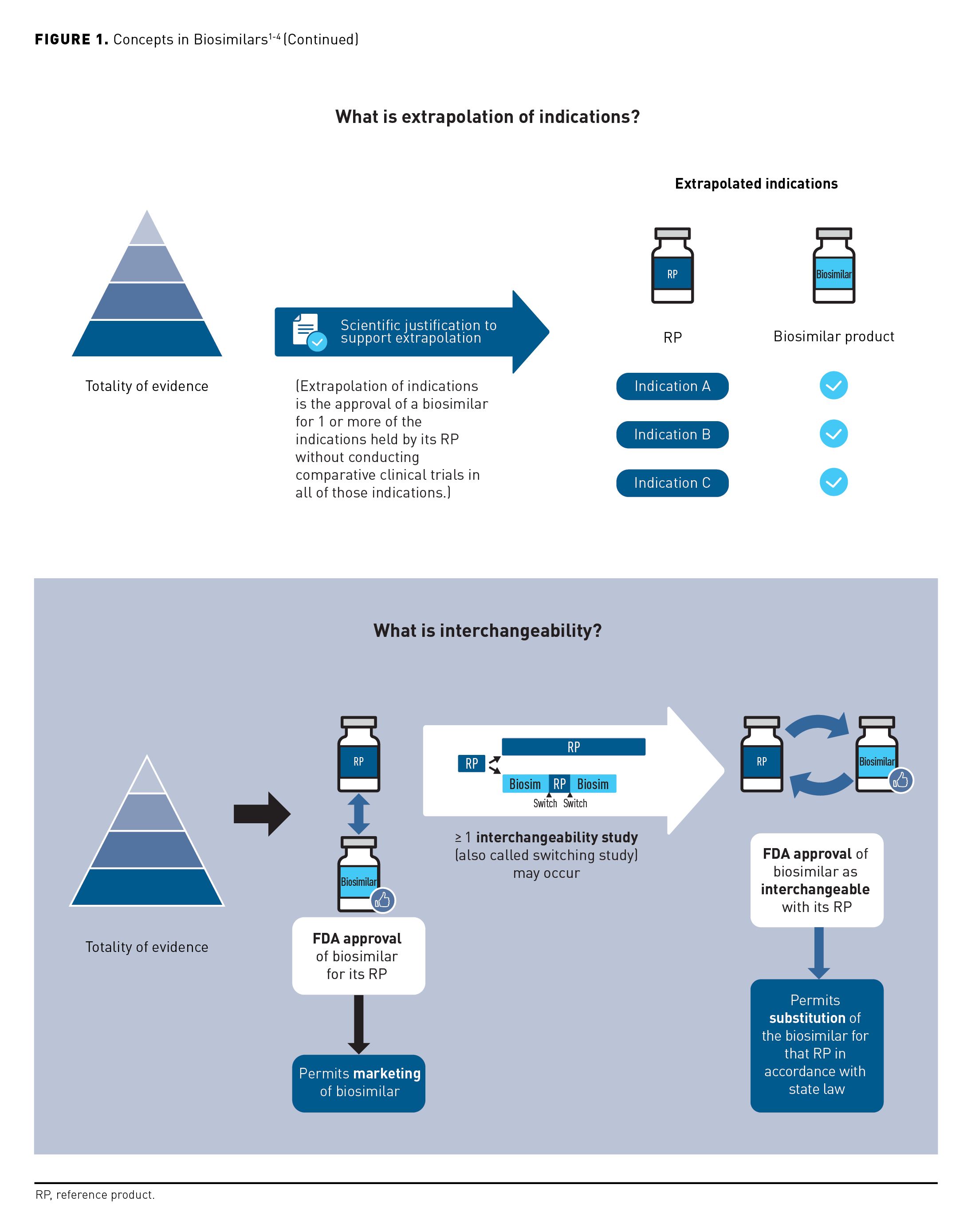
Adalimumab (Humira; AbbVie) is indicated in the United States for RA, JIA, PsA, AS, CD (adult and pediatric), PsO, hidradenitis suppurativa, and noninfectious uveitis (adult and pediatric patients ≥ 2 years). Seven FDA-approved biosimilars referencing adalimumab (Humira) will be launched in the United States in 2023, following agreements reached between the reference product sponsor and the respective biosimilar manufacturers; specifically, Amjevita (adalimumab-atto; Amgen), Cyltezo (adalimumab-adbm; Boehringer Ingelheim), Hyrimoz (adalimumab-adaz; Sandoz), Hadlima (adalimumab-bwwd; Samsung Bioepis), Abrilada (adalimumab-afzb; Pfizer), Hulio (adalimumab-fkjp; Fujifilm Kyowa Kirin Biologics/Viatris), and Yusimry (adalimumab-aqvh; Coherus BioSciences). Of these, Cyltezo (adalimumab-adbm) was approved by the FDA as interchangeable (meaning it may be substituted for its reference product by a pharmacist without the need for a new prescription from a health care provider [HCP]) in October 2021; it is the first interchangeable monoclonal antibody, and thus far the only interchangeable biosimilar to Humira.7,8 (Interchangeability is discussed below.)
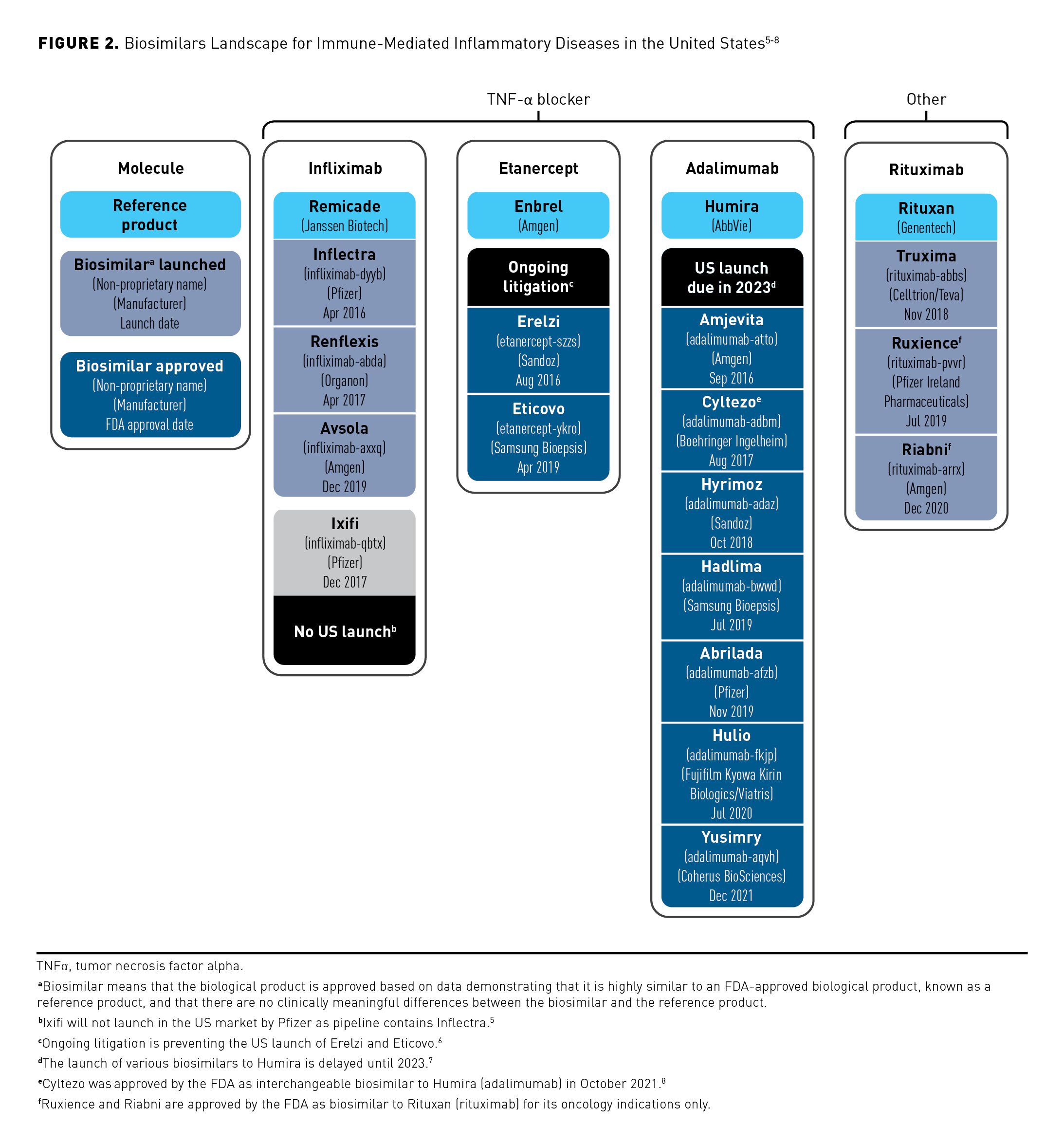
In terms of other treatment classes, rituximab (Rituxan; Genentech) is a CD20-directed cytolytic antibody that is indicated in the United States for the treatment of adults with active RA in combination with methotrexate (MTX) in patients who had an inadequate response to 1 or more anti–TNF-α therapies.10 It is also indicated in adults with non-Hodgkin lymphoma, chronic lymphocytic leukemia, Wegener granulomatosis, and pemphigus vulgaris.10 Rituximab (Rituxan) has 3 biosimilars, of which only Truxima (rituximab-abbs; Celltrion/Teva) is indicated for RA in combination with MTX; the other 2 biosimilars have oncology indications (Ruxience [rituximab-pvvr; Pfizer Ireland Pharmaceuticals] and Riabni [rituximab-arrx; Amgen]).
The development and approval pathway for biosimilars in the United States has been reviewed elsewhere.11,12 The main concepts pertaining to biosimilars and FDA regulatory processes are summarized in Figure 1.1-4 As shown, the central concept is consideration of the totality of evidence (ToE), a step-wise, risk-based approach comparing the biosimilar candidate with the FDA-approved reference product; it includes detailed structural and functional analytical characterization, toxicology studies (as needed), clinical pharmacology studies (as needed), and comparative clinical trials.2,13 Recent reviews of the FDA-approved biosimilars referencing adalimumab (Humira) reported consistent ToE findings, in that the biosimilars demonstrated equivalent efficacy, comparable safety, and highly similar immunogenicity to the reference product.9,14
If sufficient scientific justification is present, extrapolation of indications may also be considered (as shown in Figure 1).1-4,15 This is the approval of a biosimilar candidate for 1 or more of the indications held by its reference product without conducting comparative clinical trials in all of those indications. The decision to allow extrapolation of use of a biosimilar to other clinical indications for which the reference product is approved is made on a case-by-case basis by the FDA after evaluation of the ToE from the entire development program.15 Extrapolation facilitates the streamlining of biosimilar development by making it possible to avoid duplicative clinical trials and reduce development costs.16 While this should increase the accessibility of biosimilar products, it will depend on policymakers deciding which products will be stocked in hospitals/clinics and supplied per a patient’s insurance coverage.
For example, the biosimilar Amjevita (referencing adalimumab; Humira) underwent systematic ToE evaluations that demonstrated it was highly similar to its reference product and also provided scientific justification for extrapolation to all approved indications of the reference product (apart from those protected by regulatory exclusivities).17 The ToE evaluations included the following: analytical assessments that demonstrated structural and functional similarity to Humira; preclinical assessments that confirmed similar mechanisms of action and toxicology; phase 1 clinical trials that determined pharmacokinetic (PK) profiles in healthy volunteers and patients with PsO and RA; and pivotal phase 3 clinical trials patients with PsO and RA that demonstrated comparable safety, efficacy, and immunogenicity to the reference product.17
Additional regulatory requirements must be met for a biosimilar candidate to be approved by the FDA as interchangeable with its reference product (see Figure 1 and Table 1).1-4,18,19 The first FDA-approved biosimilar to be granted interchangeable status in the United States occurred on July 28, 2021 for Semglee (insulin glargine-yfgn; Viatris), a biosimilar referencing insulin glargine (Lantus; sanofi-aventis U.S.).20 As previously mentioned, Cyltezo (adalimumab-adbm) was granted interchangeability with Humira in October 2021.21 Most recently, Cimerli (ranibizumab-eqrn; Coherus BioSciences) was granted interchangeable status with Lucentis (ranibizumab; Genentech) in August 2022.22 The FDA may require data from 1 or more clinical trials intended to support the demonstration of interchangeability, often called a switching study, designed to investigate the impact of multiple switches (ie, alternating exposures) between the proposed interchangeable biosimilar and its reference product; it should include 2 or more such alternating exposures.3 FDA and legal guidance specify that “the risk in terms of safety or diminished efficacy of alternating or switching between the use of a biosimilar and the reference product is not greater than the risk of using the reference product without such alternation or switch,” and necessary data may include assessment of any differences in immunogenicity, PK, and pharmacodynamics (if available) when compared with continuous exposure to the reference product.1,3 The designation of interchangeability applies only to the individual biosimilar candidate that is FDA-approved as interchangeable and not to other biosimilars for that same reference product.18
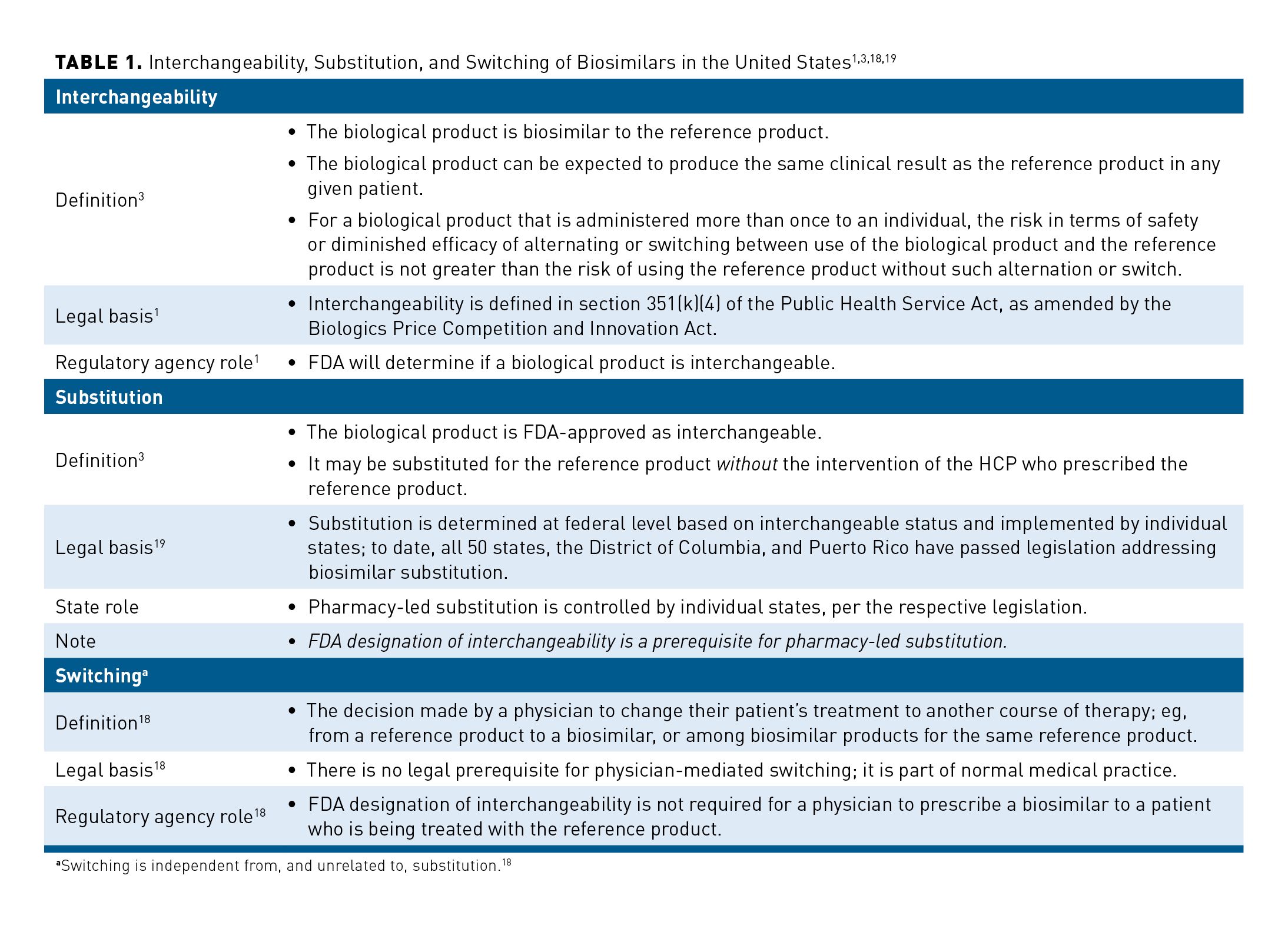
The Norwegian study NOR-SWITCH (NCT02148640) was 1 of the first biosimilar postapproval trials that provided important information on the effects of a single switch from a reference product to its biosimilar.23 This was a 52-week phase 4 trial, during which 482 patients with RA, spondyloarthropathy, PsA, PsO, or UC and on stable treatment with the infliximab reference product (Remicade; Janssen Biotech) were randomized to receive either Remicade or its biosimilar (Remsima [Inflectra in the United States], infliximab-dyyb; Celltrion). Results demonstrated that switching from infliximab reference product (Remicade) to its biosimilar (Remsima) was not inferior to continued treatment with the infliximab reference product. Noninferiority occurred across all clinical indications, but the trial was not powered to assess efficacy in specific disease populations.22 A recent systematic review of 178 studies (including immune-mediated inflammatory diseases) that included switching from a reference product to its biosimilar (and vice versa) also indicated that switching had no major effect on efficacy, safety, or immunogenicity issues.24 However, most studies analyzed consisted of a single switch.
VOLTAIRE-X (NCT03210259) was 1 of the first randomized controlled trials to report outcomes that met FDA criteria for interchangeable designation.25 This 48-week phase 3 interchangeability trial randomized 238 patients with moderate-to-severe chronic PsO and receiving reference product Humira (adalimumab) to undergo switching to biosimilar Cyltezo (adalimumab-adbm) or receive continuous Humira. Results showed that switching 3 times between Cyltezo and Humira resulted in equivalent efficacy, PK, and immunogenicity, and comparable safety between the switching and continuous treatment groups.26 These data supported the FDA’s recent designation of Cyltezo as an interchangeable biosimilar to reference product Humira.8 Cyltezo became the second biosimilar to be approved as interchangeable by the FDA to date, and the first for a TNF-α inhibitor reference product.
The designation of interchangeability is only an FDA designation that indicates a particular biosimilar meets the relevant statutory requirements. If state law permits, an interchangeable biosimilar may be substituted by a pharmacist for its reference product without permission of the HCP.18,25 Physician-mediated switching should be differentiated from nonmedical switching, which is defined as altering a treatment regimen in patients with stable disease for reasons such as drug formulary changes and/or cost reductions.27
One of the concerns related to biosimilars in general and switching between a reference product and a biosimilar is immunogenicity. This occurs due to exposure to potentially different epitopes that arise from differences in posttranslational modifications such as glycosylation during the biosimilar manufacturing process.24 In a recent review, immunogenic responses to regulatory-approved biosimilars for immune-mediated inflammatory diseases such as RA, PsO, and inflammatory bowel disease (IBD) were shown to be similar to their reference products.28 Immunogenicity results in the formation of antidrug antibodies; of these, a subset of neutralizing antibodies block the pharmaceutical action of the biologic and may lead to safety issues and/or loss of efficacy. Immunogenicity evaluations are required for biosimilar approval, and the FDA recommends a multitiered approach to testing.29 However, interpretation of the data is not straightforward, given that the assays used for the assessment of biosimilars are newer, more sensitive, and more stringent than those used years earlier with the reference products.
Barriers and Solutions to the Uptake of Biosimilars in the United States
Biosimilars have made great inroads in Europe, with 79 biosimilars obtaining regulatory approval to date, the vast majority of which have been marketed.30 This compares with 37 biosimilar approvals from the FDA, of which 22 have reached the market in the United States.22 The FDA did not approve any biosimilars in the first 6 months of 2021; 4 were approved in the second half of the year, and only 3 biosimilars were approved during 2020. The effect of the COVID-19 pandemic has shifted regulatory priorities and may cause delays in further biosimilar approvals.31 Biosimilar sales in Europe have expanded, where substantial cost savings have followed in many countries. In contrast, in 2018 in the United States, only 9% of the projected $1 billion of cost savings was achieved.32 The main barriers to the uptake of biosimilars in the United States are discussed below (see also Table 2).11,32,33
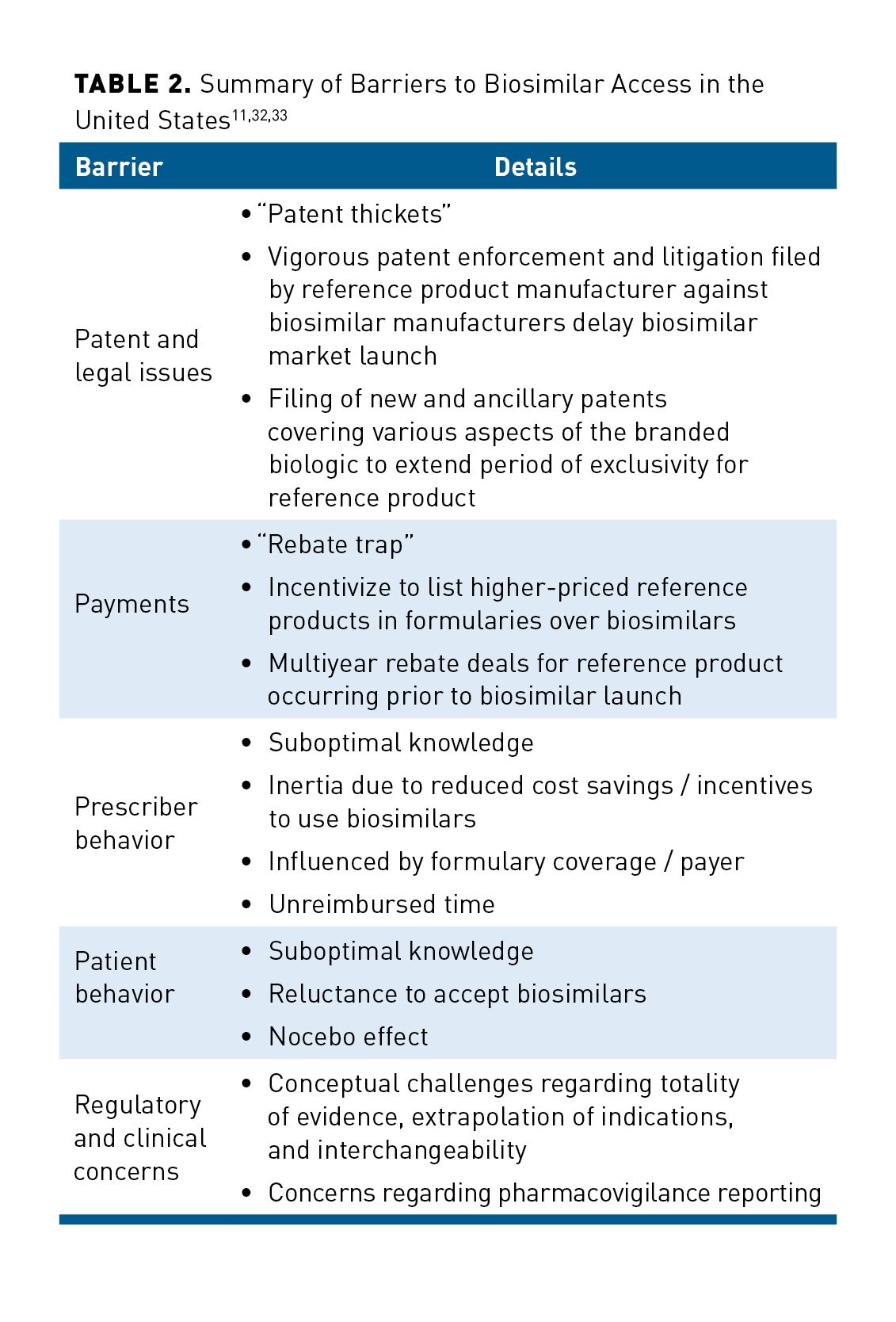
Patents and Legal Issues
The Biologics Price Competition and Innovation Act (BPCIA, 2010), part of the Patient Protection and Affordable Care Act,was passed to facilitate the entry of biosimilars into the US market.1 The BPCIA provides a framework for the exchange of confidential information, as disclosed in the abbreviated approval pathway, between the biosimilar applicant and reference product sponsor. This process, termed the “patent dance,” allows the sponsor to litigate on the patents identified. Vigorous patent strategies have created what has become known in the press as “patent thickets.” The thicket consists of potentially hundreds of ancillary patents that cover various aspects of a branded biologic and that can extend to substantially beyond when the original patent would have expired. Challenging all of the patents that could potentially cover the product makes any lawsuit a costly and protracted exercise. This can have the effect of delaying market entry of the biosimilar until a resolution can be reached, effectively extending the period of exclusivity for the reference product.32 AbbVie’s reference product Humira (adalimumab) was first approved in 2002 and has 16 indications (adult plus pediatric). AbbVie’s vigorous patent enforcement and history of litigation has successfully impeded numerous biosimilar manufacturers from launching in the United States, although settlements have been reached to permit launches in 2023.34 Similarly, Amgen is also using patent litigation successfully against 2 biosimilars to its reference product Enbrel (etanercept), namely, Erelzi (Sandoz) and Eticovo (Samsung Bioepsis).35 FDA approved Erelzi in 2016 and Eticovo in 2019, but neither have made it to market in the United States. It is hoped that the passage of the Biologic Product Patent Transparency Act, which requires the listing of patents in the FDA’s Purple Book (a public database of licensed biologics), will help reduce the number of patents issued after a biosimilar approval application has been submitted to the FDA, thus reducing the number of patents that can be enforced against a biosimilar.32
Payments
Pharmacy benefit managers (PBMs) are organizations that negotiate drug spending with drug manufacturers and pharmacies on behalf of payers (eg, health insurers, Medicare Part D, employers) and develop formularies (lists of generic and brand-name prescription drugs covered by a particular health plan). Drug manufacturers may use financial incentives such as discounts and rebates to encourage PBMs to list higher-priced reference products in formularies over biosimilars. This is known as the “rebate trap.” Also, multiyear rebate deals for a reference product may be offered immediately prior to a biosimilar launch date, which affects demand for the newer product.32 Calls for greater transparency concerning rebates remain unanswered. Only 2 health care systems require the use of biosimilars: Kaiser Permanente and the Veterans Administration (VA) Health System. Kaiser Permanente leveraged its integrated model (combining coverage and delivery of care) to use biosimilars to improve affordability for their patients and their health care system.36 For example, use of the biosimilar Inflectra (reference product Remicade, infliximab) by Kaiser Permanente far exceeds regular market utilization (80% vs 3.2%, respectively). In addition, clinician decision-making is not influenced by reimbursement, so it facilitates financially neutral prescribing. Similarly, the VA Health System has mandated switching patients to a biosimilar for Remicade.37
Prescriber Behavior
The willingness of prescribing physicians to use biosimilars may be influenced by various factors, including reduced cost savings, and/or incentives for switching to a biosimilar; formulary status, particularly the inconsistent coverage of individual biosimilars in formularies or by payers; and extra time needed with patients to explain biosimilars.32,38,39 HCPs’ lack of familiarity with biosimilars may act as a deterrent to biosimilar use. This was demonstrated in a review of survey data from HCPs (published from 2014 to 2017; US and Europe; hospital specialists, gastroenterologists, and rheumatologists were most frequently surveyed), demonstrating that limited understanding of biosimilars contributed to concerns about efficacy and safety, and reduced prescribing.40 A recent systematic review of survey data (mainly collected prior to 2017; mostly European data) reported that 49% to 76% of physicians were familiar with biosimilars, but up to 25% did not know what biosimilars were.41 (Survey data are described in the second article in this supplement.42) The biosimilars knowledge gap may be exacerbated by criticism and misrepresentation of the science and policy regulating biosimilars, creating negative perceptions and further impeding decision-making by HCPs.43
Patient Behavior
Patient surveys regarding biosimilars reveal similar knowledge gaps and concerns to those of HCPs in relation to efficacy and safety.44 Furthermore, data from a narrative review of clinical and real-world evidence revealed that patients often do not understand the need to change medication to a biosimilar when their current treatment is satisfactory.45 Another factor influencing biosimilar uptake is the “nocebo effect,” defined as the negative effect of medical treatment induced by patient expectations that is unrelated to the physiological action of the treatment.46 Failure of nonmedical switching from a reference product to a biosimilar has been attributed to the nocebo effect in some open-label and observational studies; however, other commentators believe this may be too simplistic an explanation.24,47
Regulatory and Clinical Concerns
Various conceptual challenges exist regarding biosimilar science and policy.32,40,43 For example, per the BPCIA, biosimilar approvals by the FDA use an abbreviated licensure pathway, and the word “abbreviated” may be erroneously associated with reduced thoroughness.43 Similarly, the idea of biosimilar approvals based on ToE is a new concept for HCPs, and it differs from the more familiar regulatory approval process associated with reference products.43 Extrapolation of indications is another concept that may be problematic for HCPs and patients alike, as newly approved products are investigated in clinical trials in disease-specific patient populations for each clinical indication being sought.43 As mentioned, the definitions of (and differences between) biosimilar interchangeability, pharmacist-led substitution, and switching may be unclear.18,43
Concerns about biosimilar safety may be addressed by improving pharmacovigilance reporting and, hopefully, increasing confidence in biosimilars from patients and physicians, and promoting their wider acceptance.48 To facilitate identification, the FDA recommends that biosimilars (and other biologics) receive a 4-letter suffix appended to the core name. For example, Humira (adalimumab) biosimilars are named Amjevita (adalimumab-atto), Cyltezo (adalimumab-adbm), and Hulio (adalimumab-fkjp) (see Figure 2).5-8,49 The use of these distinguishable nonproprietary names for biosimilars in the United States is central for accurate prescribing, prevention of possible accidental pharmacy substitution for a noninterchangeable biosimilar, and safety surveillance for correct attribution of any adverse drug reaction reported.48
Possible Solutions
The key solutions to reducing barriers and increasing uptake of biosimilars in the United States are education and communication. Biosimilar education for HCPs should occur as part of the curriculum in medical, pharmacy, and nursing schools.43,50 Patients, caregivers, and other laypersons should receive plain language and graphical versions of biosimilar educational materials, such as those provided online by the FDA in “Biosimilar Basics.”51 Similarly, educational opportunities for payers (eg, United Heath Group, Medicaid) and providers (individual hospitals and clinics) are also required to facilitate the addition of biosimilars into formularies.52 Clinical pharmacists may have a key role in educating physicians and patients about biosimilars, in the same way that they have helped to increase the acceptability and utilization of generic drugs.53 The FDA’s Biosimilar Action Plan, which describes key actions taken by the FDA to encourage innovation and competition among biologics and the development of biosimilars, states the importance of developing audience-appropriate educational materials and tools for clinicians, patients, and payers regarding biosimilar and interchangeable biosimilar products.48,54 Recently, the Advancing Education on Biosimilars Act of 2021 was signed, authorizing the FDA to educate patients and HCPs on the benefits of biosimilars, with the aim of promoting increased uptake of biosimilars following their entry into the market.55
Effective communication is integral to biosimilar education. In terms of communication about biosimilars between HCPs and patients, a recent review recommended that patients be provided with understandable information that is presented in a positive and transparent manner, that is tailored to each individual, that is consistent and coherent across different resources, and that is supported by audiovisual material.56 Organizations representing patients (eg, associations, groups, forums) also have an important role in correctly informing patients about biosimilars.56 In addition, biosimilar advocacy organizations, as well as individual biosimilar manufacturers and sponsors, have a role in communication and education of HCPs and other stakeholders.
Conclusions
Biosimilars offer the potential to deliver substantial cost savings in biologic therapy and to contribute to increased patient access to these expensive treatments; this is particularly relevant for immune-mediated inflammatory diseases, given the number of patients affected by and receiving treatment for these conditions. This has been well demonstrated in European markets, where many biosimilars are available, including multiple biosimilars for the same reference product. For the United States to benefit from bringing biosimilar pipeline products to the market, legal and price-related barriers to competition need to be addressed as a priority. Education of prescribers, patients, payers, and providers is also essential to increase uptake as biosimilars reach the market.
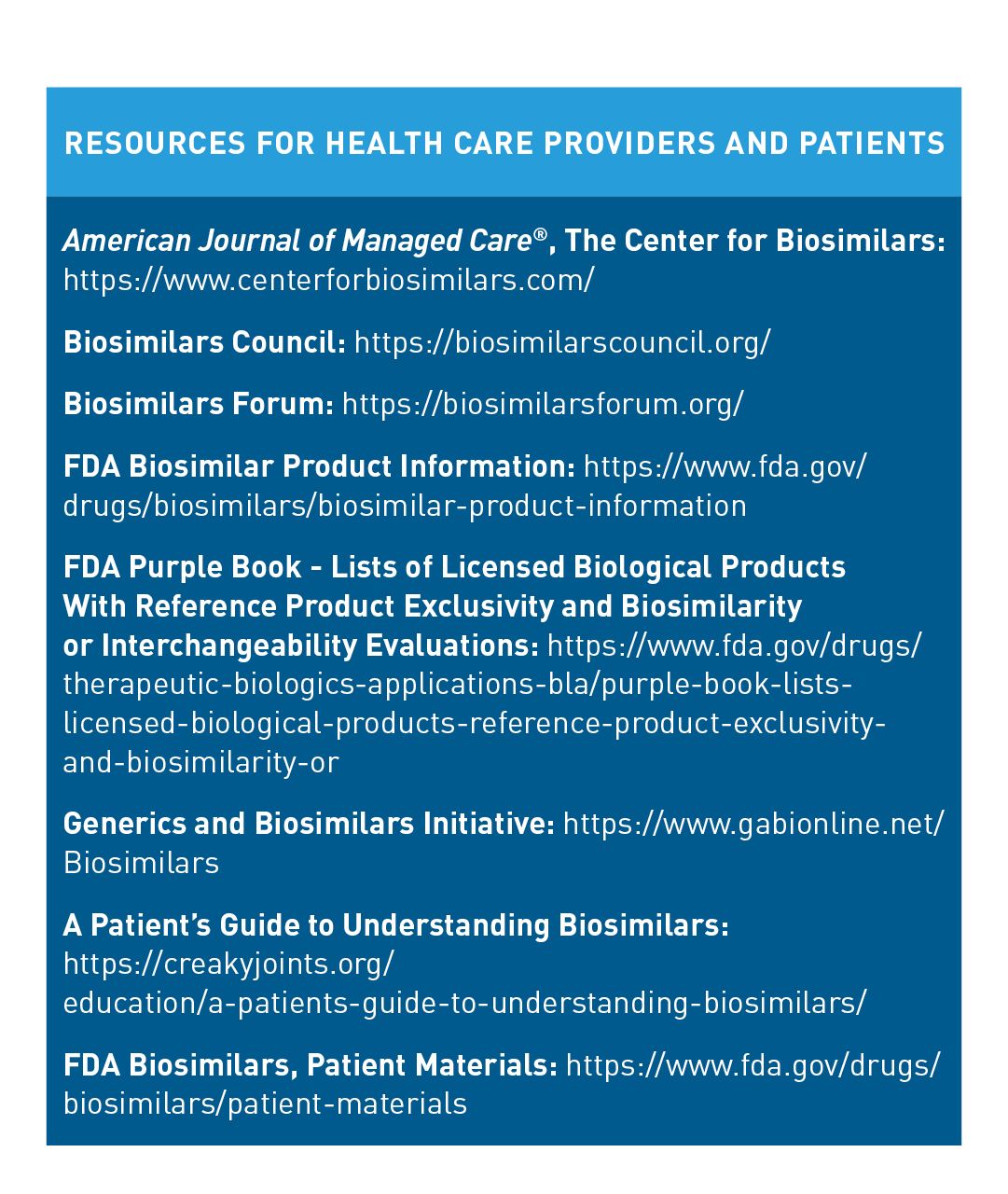
Acknowledgments
The authors meet criteria for authorship as recommended by the International Committee of Medical Journal Editors (ICMJE). The authors received no direct compensation related to the development of the manuscript. Writing, editorial support, and formatting assistance was provided by Debra Brocksmith, MBChB, PhD, of Elevate Scientific Solutions, which was contracted and funded by Boehringer Ingelheim Pharmaceuticals, Inc. (BIPI). BIPI was given the opportunity to review the manuscript for medical and scientific accuracy as well as intellectual property considerations.
Data Sharing
Data sharing is not applicable to this article, as no new data were created or analyzed in this report.
Author Affiliations: Division of Immunology & Rheumatology, Department of Medicine, Stanford University (VS), Palo Alto, CA; National Psoriasis Foundation (former/retired; CE), Austin, TX; Weill Cornell Medicine and Hospital for Special Surgery (AG), New York, NY.
Author ORCID iD: Vibeke Strand, MD (https://orcid.org/0000-0003-4978-4072).
Funding Source: This supplement was supported by Boehringer Ingelheim Pharmaceuticals, Inc.
Author Disclosures: Dr Strand reports serving as a consultant/advisor for AbbVie, Amgen, Arena Pharmaceuticals, Aria Pharmaceuticals, AstraZeneca, Bayer, Bristol Myers Squibb, Bioventus, Boehringer Ingelheim, Celltrion, ChemoCentryx, EMD Serono, Endo, Equillium, Galapagos, Genentech/Roche, Gilead Sciences, GSK, Horizon, Ichnos Sciences, Inmedix, Janssen, Kiniksa Pharmaceuticals, Kypha, Lilly, Merck, MiMedx, Novartis, Pfizer, Regeneron, Rheos Medicines, R-Pharm US, Samsung, Sandoz, Sanofi, Scipher Medicine, Servier Pharmaceuticals, SetPoint Medical, Sorrento Therapeutics, Sun Pharma, and UCB. Dr Evans reports serving as a volunteer board member for the National Psoriasis Foundation and serving as a consultant or paid advisory board member for Celgene. He has received honoraria from Celgene and Cigna, and he reports being on the speakers’ bureau for AbbVie and Celgene. Dr Gibofsky reports serving as a consultant/advisor to AbbVie, Biosplice Therapeutics, Lilly, Novartis, and Pfizer; he reports being on the speakers’ bureau for AbbVie, Amgen, and Pfizer; and he reports owning stock in AbbVie, Amgen, Bristol Myers Squibb, and Pfizer.
Authorship Information: Analysis and interpretation of data (VS, CE, AG); drafting of the manuscript (VS, CE, AG); critical revision of the manuscript for important intellectual content (VS, CE, AG).
Address Correspondence to: Vibeke Strand, MD. Email: vstrand@stanford.edu
References
1. Patient Protection and Affordable Care Act, HR 3590, 111th Cong (2010). Accessed June 04, 2022. https://www.fda.gov/downloads/drugs/guidancecomplianceregulatoryinformation/ucm216146.pdf
2. Scientific considerations in demonstrating biosimilarity to a reference product; guidance for industry. FDA. April 2015. Accessed June 08, 2022. https://www.fda.gov/media/82647/download
3. Considerations in demonstrating interchangeability with a reference product: guidance for industry. FDA. May 2019. Accessed June 04, 2022. https://www.fda.gov/media/124907/download
4. State laws for biosimilar interchangeability. Cardinal Health. Accessed December 20, 2021.
Accessed July 31, 2022. https://www.cardinalhealth.com/en/product-solutions/pharmaceutical-products/biosimilars/state-regulations-for-biosimilar.html
5. The Center for Biosimilars. Biosimilar pipeline congested by patent litigation bottleneck. February 11, 2020. Accessed June 22, 2022. https://www.centerforbiosimilars.com/view/conference-biosimilar-pipeline-congested-by-litigation-bottleneck
6. Englehardt J, Weiss M. 2021 Biosimilar approval and litigation update. JD Supra Biologics Blog. February 1, 2021. Accessed June 08, 2022. https://www.jdsupra.com/legalnews/2021-biosimilar-approval-and-litigation-1427785
7. Biosimilars 101: Practice concerns, market acceptance, and the biosimilars pipeline. AJMC® The Center for Biosimilars. Accessed July 29, 2022. https://www.centerforbiosimilars.com/resources?display=recent
8. U.S. FDA approves Cyltezo® (adalimumab-adbm) as first interchangeable biosimilar with Humira. News release. Boehringer Ingelheim. October 15, 2021. Accessed July 29, 2022. https://www.boehringer-ingelheim.us/press-release/us-fda-approves-cyltezo-adalimumab-adbm-first-interchangeable-biosimilar-humira
9. Huizinga TWJ, Torii Y, Muniz R. Adalimumab biosimilars in the treatment of rheumatoid arthritis: a systematic review of the evidence for biosimilarity. Rheumatol Ther. 2021;8(1):41-61. doi:10.1007/s40744-020-00259-8
10. Rituxan. Prescribing information. Biogen/Genentech; 2020. Accessed July 29, 2022. https://www.accessdata.fda.gov/drugsatfda_docs/label/2020/103705s5460lbl.pdf
11. Brasington R, Strand V. New treatments in rheumatology: biosimilars. Curr Treatm Opt Rheumatol. 2020;6:325-336. doi:10.1007/s40674-020-00159-6
12. Lucio S. The complexities of biosimilars and the regulatory approval process. Am J Manag Care. 2018;24(suppl 11):S231-S236.
13. Biosimilar product regulatory review and approval. FDA. October 16, 2017. Accessed June 04, 2022. https://www.fda.gov/media/108621/download
14. Lu X, Hu R, Peng L, Liu M, Sun Z. Efficacy and safety of adalimumab biosimilars: current critical clinical data in rheumatoid arthritis. Front Immunol. 2021;12:638444. doi:3389/fimmu.2021.638444
15. Tesser JR, Furst DE, Jacobs I. Biosimilars and the extrapolation of indications for inflammatory conditions. Biologics. 2017;11:5-11. doi:10.2147/BTT.S124476.
16. Extrapolation of clinical data for multiple biosimilar indications. Pfizer. August 2021. Accessed June 08, 2022. https://www.pfizerbiosimilars.com/biosimilars-extrapolation
17. Markus R, McBride HJ, Ramchandani M, et al. A review of the totality of evidence supporting the development of the first adalimumab biosimilar ABP 501. Adv Ther. 2019;36(8):1833-1850. doi:10.1007/s12325-019-00979-6
18. McKinley L, Kelton JM, Popovian R. Sowing confusion in the field: the interchangeable use of biosimilar terminology. Curr Med Res Opin. 2019;35(4):619-621. doi:10.1080/03007995.2018.1560223
19. State laws and legislation related to biologic medications and substitution of biosimilars. National Conference of State Legislatures. May 3, 2019. Accessed June 23, 2022. https://www.ncsl.org/research/health/state-laws-and-legislation-related-to-biologic-medications-and-substitution-of-biosimilars.aspx
20. FDA approves first interchangeable biosimilar insulin product for treatment of diabetes. News release. FDA. July 28, 2021. Accessed August 2, 2022. https://www.fda.gov/news-events/press-announcements/fda-approves-first-interchangeable-biosimilar-insulin-product-treatment-diabetes
21. FDA approves Cyltezo, the first interchangeable biosimilar to Humira. News release. FDA. October 18, 2021. Accessed June 01, 2022. https://www.fda.gov/news-events/press-announcements/fda-approves-cyltezo-first-interchangeable-biosimilar-humira
22. Biosimilar approval status in the US: FDA filing dates and actions. Biosimilars Review & Report. Updated August 2022. Accessed August 5, 2022. https://biosimilarsrr.com/us-biosimilar-filings
23. Jorgensen KK, Olsen IC, Goll GL, et al. Switching from originator infliximab to biosimilar CT-P13 compared with maintained treatment with originator infliximab (NOR-SWITCH): a 52-week, randomised, double-blind, non-inferiority trial. Lancet. 2017;389(10086):2304-2316. doi:10.1016/S0140-6736(17)30068-5
24. Barbier L, Ebbers HC, Declerck P, Simoens S, Vulto AG, Huys I. The efficacy, safety, and immunogenicity of switching between reference biopharmaceuticals and biosimilars: a systematic review. Clin Pharmacol Ther. 2020;108(4):734-755. doi:10.1002/cpt.1836
25. Menter A, Cohen S, Kay J, et al. Switching between adalimumab reference product and BI 695501 in patients with chronic plaque psoriasis (VOLTAIRE-X): a randomized controlled trial. Am J Clin Derm. 2022;23(5):719-728. doi: 10.1007/s40257-022-00708-w
26. What does interchangeable mean? Biosimilars Forum. Accessed June 11, 2022. https://biosimilarsforum.org/biosimilars-insights/biosimilars-faqs
27. Dolinar R, Kohn CG, Lavernia F, Nguyen E. The non-medical switching of prescription medications. Postgrad Med. 2019;131(5):335-341. doi:10.1080/00325481.2019.1618195
28. Strand V, Goncalves J, Hickling TP, Jones HE, Marshall L, Isaacs JD. Immunogenicity of biosimilars for rheumatic diseases, plaque psoriasis, and inflammatory bowel disease: a review from clinical trials and regulatory documents. BioDrugs. 2020;34(1):27-37. doi:10.1007/s40259-019-00394-x
29. Immunogenicity testing of therapeutic protein products—developing and validating assays for anti-drug antibody detection: guidance for industry. FDA. January 2019. Accessed June 09, 2022. https://www.fda.gov/media/119788/download
30. Medicines, biosimilars. European Medicines Agency. Accessed June 09, 2022. https://www.ema.europa.eu/en/medicines/field_ema_web_categories%253Aname_field/Human/ema_group_types/ema_medicine/field_ema_med_status/authorised-36/ema_medicine_types/field_ema_med_biosimilar/search_api_aggregation_ema_medicine_types/field_ema_med_biosimilar
31. How the U.S. compares to Europe on biosimilar approvals and products in the pipeline. Rothwell Figg Law Bulletin. March 2021. Accessed June 09, 2022. https://www.biosimilarsip.com/2021/03/08/how-the-u-s-compares-to-europe-on-biosimilar-approvals-and-products-in-the-pipeline-6
32. Yazdany J. Failure to launch: biosimilar sales continue to fall flat in the United States. Arthritis Rheumatol. 2020;72(6):870-873. doi:10.1002/art.41203
33. Halimi V, Daci A, Ancevska Netkovska K, Suturkova L, Babar ZU, Grozdanova A. Clinical and regulatory concerns of biosimilars: a review of literature. Int J Environ Res Public Health. 2020;17(16). doi:10.3390/ijerph17165800
34. AbbVie’s successful hard-ball with Humira legal strategy unlikely to spawn similar efforts; potential appeals outcome unclear. Pharmaceutical Technology. February 2021. Accessed June 10, 2022. https://www.pharmaceutical-technology.com/comment/abbvies-successful-hard-ball-with-humira
35. Sandoz is 0-3 in Enbrel patent case. AJMC® The Center for Biosimilars. May 17, 2021. Accessed June 10, 2022. https://www.centerforbiosimilars.com/view/sandoz-is-0-3-in-enbrel-patent-case
36. Biosimilars at Kaiser Permanente. Kaiser Permanente. December 2020. Accessed June 11, 2022. https://www.kpihp.org/wp-content/uploads/2020/12/Biosimilars_at_KP_121420_FINAL.pdf
37. Nagowski C. Biosimilar coverage by the VA—what you need to know. Biosimilar Development. December 2018. Accessed June 11, 2022. https://www.biosimilardevelopment.com/doc/biosimilar-coverage-by-the-va-what-you-need-to-know-0001
38. Kolbe AR, Kearsley A, Merchant L, et al. Physician understanding and willingness to prescribe biosimilars: findings from a US national survey. BioDrugs. 2021;35(3):363-372. doi:10.1007/s40259-021-00479-6
39. Chen A. Insurer formularies complicate the adoption of biosimilar cancer therapies. USC Schaeffer Center for Health Policy & Economics. April 2021. Accessed June 11, 2022. https://healthpolicy.usc.edu/article/insurer-formularies-complicate-the-adoption-of-biosimilar-cancer-therapies
40. Leonard E, Wascovich M, Oskouei S, Gurz P, Carpenter D. Factors affecting health care provider knowledge and acceptance of biosimilar medicines: a systematic review. J Manag Care Spec Pharm. 2019;25(1):102-112. doi:10.18553/jmcp.2019.25.1.102
41. Sarnola K, Merikoski M, Jyrkka J, Hameen-Anttila K. Physicians’ perceptions of the uptake of biosimilars: a systematic review. BMJ Open. 2020;10(5):e034183. doi:10.1136/bmjopen-2019-034183
42. Gibofsky A, Evans C, Strand V. Provider and patient knowledge gaps on biosimilars: insights from surveys. Am J Manag Care. 2022;28(suppl 12):S227-S233
43. Cohen HP, McCabe D. The importance of countering biosimilar disparagement and misinformation. BioDrugs. 2020;34(4):407-414. doi:10.1007/s40259-020-00433-y
44. Kovitwanichkanont T, Raghunath S, Wang D, et al. Who is afraid of biosimilars? Openness to biosimilars in an Australian cohort of patients with rheumatoid arthritis. Intern Med J. 2020;50(3):374-377. doi:10.1111/imj.14753
45. Gecse KB, Cumming F, D’Haens G. Biosimilars for inflammatory bowel disease: how can healthcare professionals help address patients’ concerns? Expert Rev Gastroenterol Hepatol. 2019;13(2):143-155.
doi:10.1080/17474124.2019.1553617
46. Pouillon L, Socha M, Demore B, et al. The nocebo effect: a clinical challenge in the era of biosimilars. Expert Rev Clin Immunol. 2018;14(9):739-749. doi:10.1080/1744666X.2018.1512406
47. Fleischmann R, Jairath V, Mysler E, Nicholls D, Declerck P. Nonmedical switching from originators to biosimilars: does the nocebo effect explain treatment failures and adverse events in rheumatology and gastroenterology? Rheumatol Ther. 2020;7(1):35-64. doi:10.1007/s40744-019-00190-7
48. Jordan JB, Christl L. FDA Biosimilar action plan: could improving pharmacovigilance of biologics improve patient and physician confidence in biosimilars? Expert Opin Drug Saf. 2020;19(3):229-232. doi:10.1080/14740338.2020.1733966
49. Nonproprietary naming of biological products: guidance for industry. FDA. January 2017. Accessed August 2, 2022. https://www.fda.gov/downloads/drugs/guidances/ucm459987.pdf
50. Curriculum materials for health care degree programs. Biosimilars. FDA. December 20, 2021. Accessed April, 03, 2022. https://www.fda.gov/drugs/biosimilars/curriculum-materials-health-care-degree-programs-biosimilars
51. Biosimilar basics for patients. FDA. Accessed August 2, 2022. https://www.fda.gov/drugs/biosimilars/patient-materials
52. Smeeding J, Malone DC, Ramchandani M, Stolshek B, Green L, Schneider P. Biosimilars: considerations for payers. P T. 2019;44(2):54-63.
53. Okoro R. Biosimilar medicines uptake: the role of the clinical pharmacist. Explor Res Clin Soc Pharm. 2021;1:100008. doi:10.1016/j.rcsop.2021.100008
54. Biosimilars action plan. FDA. July 2018. Accessed June 11, 2022. https://www.fda.gov/media/114574/download
55. Advancing Education on Biosimilars Act. S 164, 117th Cong (2021). Congress.gov. Accessed August 2, 2022. https://www.congress.gov/bill/117th-congress/senate-bill/164
56. Vandenplas Y, Simoens S, Van Wilder P, Vulto AG, Huys I. Informing patients about biosimilar medicines: the role of European patient associations. Pharmaceuticals (Basel). 2021;14(2):117. doi:10.3390/ph14020117

